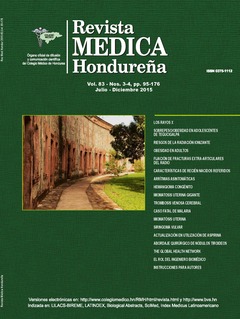Cerebral venous thrombosis, about 5 cases in adults and review, Honduras, 2015
Keywords:
Cerebral Venous Thrombosis,, disabilityAbstract
Introduction: cerebral venous sinus thrombosis (CVST) represents 0.5 to 1% of strokes, despite technological advances, the diagnosis can be difficult; so we proposed epidemiologically characterize cases of cerebral venous sinus thrombosis treated at the Hospital Escuela Universitario. Clinical cases: Observational case series was conducted, the definition of confirmed case was: a patient with severe headache, does not yield with analgesics, visual disturbances, seizures and neurological deficits, demonstrating through imaging filling defects in the cerebral venous system; we collected general information, date of onset of symptoms, risk factors, clinical manifestations, thrombosis location, Rankin Scale at hospital exit and after one month. Data were analyzed using Microsoft Excel 2007® by simple frequencies, relative, ranges, averages. Discussion: 60 suspect, zero probable and five confirmed cases (8.3%) were found with CVST, mean age: 33.8 (20-40 years), all women, identified risk factors: pregnancy / postpartum puncture lumbar, oral contraceptives, malignancy, sickle cell anemia. Clinical manifestations were: intracranial hypertension, headache and convulsions; The most frequently imaging performed was brain CT Angiogram. All cases were treated with anticoagulation and had improvement in disability score a month later. Conclusions: All cases were women, the risk factors were: pregnancy / postpartum period, lumbar puncture, oral contraceptives, malignancies, sickle cell anemia, the clinical manifestations were: intracranial hypertension, headache and convulsions; He died and had no improvement in disability score.
Downloads
173




